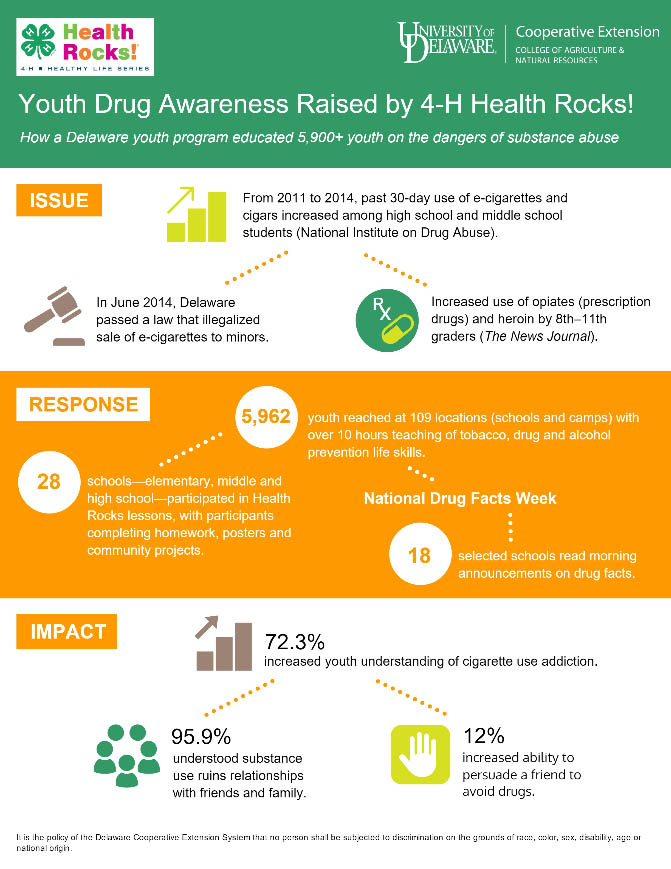
Health Rocks Healthy Living Curriculum
- Health & Well-being
-
Agricultural Programs
- Agribusiness
- Animal Science
- Beginning Farmer Program
- Commercial Crops
- Commericial Horticulture
- Delaware Soil Testing Program
- Disease Management
- Farm Vitality and Health Project
- Irrigation
- Nutrient Management
-
Insect Pest Management
- Insect Trapping Program
- IPM Hot Topics
- Commercial Field Crop Insect Management
- Commercial Field Crop Disease Management
- Commercial Fruit & Vegetable Crop Pest Management
- EIPM Implementation Projects
- Pollinators
- Research and Extension Demonstration Results
- Brown Marmorated Stink Bug (BMSB) Management, Research, and Resources
- Publications
- Pesticide Safety Education Program
- UD Plant Diagnostic Clinic
- Variety Trials
- Weed Science
- Certified Crop Advisor Program
- Poultry Biosecurity
- 4-H
-
Horticulture
- Climate Variability and Change
- Delaware Soil Testing Program
- Forestry
- Lawn and Garden
- Master Gardeners
- Master Naturalist Program
-
Nutrient Management
- Nutrient Management Certification
- Continuing Education for Nutrient Management
- Nutrient Management Planning Resources
- Commercial Nutrient Handler Resources
- Poultry Litter and Manure Management
- Turf Management
- Agriculture Notebook
- Horticulture Handbook
- Agriculture & Horticulture Handbooks
- Crop Production
- Soil Fertility
- Delaware Climate Change Coordination Initiative (DECCCI)
- Salt Impacted Agricultural Lands

ISSUE
The University’s “Kids Count in Delaware Study” reveals that cigarettes smoking, marijuana, and alcohol use continues to rise in students in grades 5 thru 11.
RESPONSE
The goal for Delaware was to reach 7000 youth in 2012 with 10 hours of Health Rocks Healthy Living Curriculum. During this performance year we doubled the number of youth trainers and increased the locations and agencies by 100% over last year to 130. We also more than doubled our reach of youth who received the Health Rocks Program and surpassed the 7000 youth to 7500 youth thus totaling 12248 youth for a three year initiative.
How we did it included a 50% salaried person, myself as project manager, a public ally, and continued one miscellaneous wage support staff at 15 -20 hours per week.
We included the delivery of the program in 4-H camps by making the modules camp friendly, and conducting state wide camp counselor training in all three counties. These volunteer counselors account for 5% of the youth reached. The stipend trainer staff has done an excellent job where ever they taught. Whenever we call a camp, school or after schools to rebook, they are excited to have Health Rocks return. The stipend youth and adult trainers are responsible for 51% of our reach.
Another way we multiplied ourselves was by training teachers and agencies in the curriculum. They conduct the program on their own. This accounts for 10% of our total reach.
The Public Ally and the miscellaneous wage staff are responsible for the remaining 34% of youth reached.
IMPACT
Evaluation Data: One might fear that quantity would hurt quality, but the evaluation data that was quantified by the University of Nebraska shows excellent results. The training crosses all demographic lines and shows % increases in life skills and knowledge up to 14% improvement. That data is available at http://extension.udel.edu/4h/projects-activities-for-members/youth-substance-abuse/health-rocks/
During this performance year we doubled the number of youth trainers and increased the locations and agencies by 100% over last year. We also more than doubled our reach of youth who received the Health Rocks Program and surpassed the 7000 youth to 7500 youth.
Credit to: Karen Johnson, June 2013
The University of Delaware is an Equal Opportunity Institution and Provider. Visit UD’s Office of Equity & Inclusion to learn more.
Additional Links
531 South College Avenue Newark, DE 19716 (302) 831-2501
